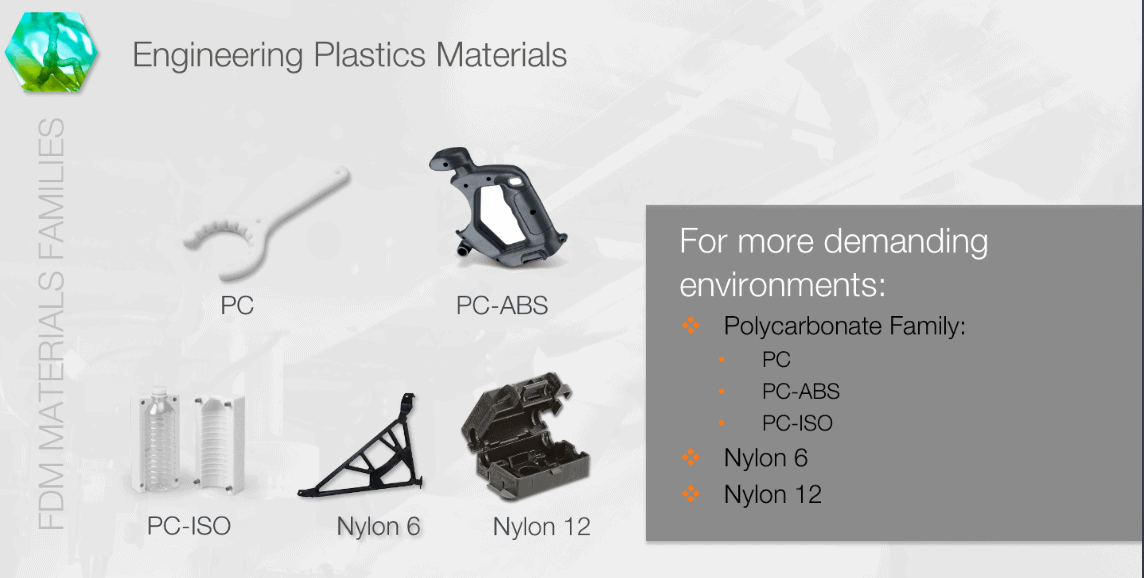FDM Material Highlights
FDM Material Highlights
FDM (Fused Deposition Modeling) technology is the engineering workhorse in the Stratasys portfolio. Offering numerous real world thermoplastic material options, it has great potential to fit many functionally demanding applications.
FDM works by heating a thermoplastic filament into a liquid, then depositing that liquid plastic through a precision nozzle to form the desired geometry. Think of a spool of weed wacker wire being fed into a CNC hot glue gun, same basic concept.
https://gfycat.com/FriendlyEmbellishedHound
One of the big advantages of using FDM to make your parts is the ability to use real world engineering thermoplastics with well known properties. Thermoplastics are materials that can be heated and cooled multiple times to transition from solid to liquid, as opposed to thermoset plastics that undergo an irreversible transition from liquid to solid. These thermoplastic materials available on Stratasys FDM printers are broken down into three families based on application. They are standard plastics, engineering plastics, and high performance plastics.
Standard Plastics

ABSplus(Acrylonitrile butadiene styrene) This is classic ABS as used in the plastics industry for years. This is what LEGO blocks are made from.
ABS-M30 Similar to ABSplus, but with significant increase in layer bond strength. Ideal for applications where increased strength and durability is required.
ABSi Stronger than ABSplus, and also translucent. Used for applications where light transmission or visibility is required.
ABS-M30i Identical to ABS-M30 with the added benefit of being able to be used in medical or food production applications.
ABS-ESD7 Ideal for use in the electronics industry due to its ability to prevent a buildup of electro-static charge.
ASA (Acrylonitrile Styrene Acrylate) Similar mechanical properties to ABSplus, with the ability to resist UV degradation. Mainly used in outdoor applications
PLA (Polylactic Acid) Economic material alternative made from renewable resources.
Engineering Plastics

PC (Polycarbonate) A well known industrial thermoplastic, ideal for mechanically demanding applications. Stronger and more rigid then ABS.
PC-ABS A combination of both PC and ABS offering strength, heat resistance, and flexibility.
PC-ISO (Polycarbonate-ISO) A PC option with the ability to be sterilized for medical or food grade applications.
Nylon 6 One of the strongest and toughest materials available.
Nylon 12 High toughness material popular for its great price for performance.
High Performance Plastics

ULTEM 9085 Extremely tough material and Flame, Smoke, and toxicity certification make this an ideal military or automotive material.
ULTEM 9085 Aerospace Essentially the same material as its non-aerospace counterpart, but includes stringent process documentation required by the aerospace industry.
ULTEM 1010 Similar material in mechanical properties to ULTEM 9085 with the added benefit of bio-compatibility certifications for use in medical or food industry applications.
Nylon 12-CF CF stands for carbon fiber, giving this nylon 12 derivative increased stiffness and strength to weight ratio. Tiny micro-fibers of carbon suspended in a nylon 12 matrix act very similarly to how steel rebar is used to reinforce concrete. Both materials support each other under different types of loads to create one material stronger than its individual components.
PPSF/PPSU (Polyphenylsulfone) The extreme heat resistance of this material lends itself to applications such as under the hood prototypes in the automotive industry.
More information including material spec sheets can be found here.

 Blog
Blog